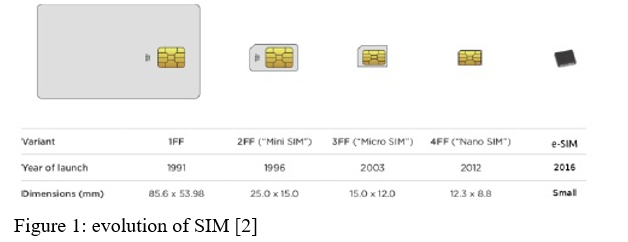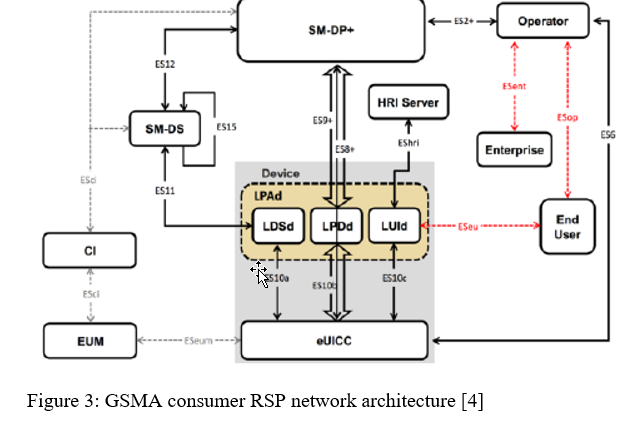Technology evolution from traditional Subscriber Identity Module (SIM) to embedded SIM (eSIM)
By Eng. Amila SaputhanthriIntroduction
Subscriber Identity Module (SIM) consists of a microcontroller and a plastic card body. It's a removable hardware security module which is responsible for protection of customer profile data, authorization of subscriber to operator's network (The mobile operator from where the customer has purchased the subscription) and containing personalized storage parameters [1]. The data contained in the SIM includes:
- ICCID - Integrated Circuit Card Identifier is a unique identification of the SIM
- IMSI - International Mobile Subscriber Identity is a parameter to identify the operator's network
- Authentication key (KI) - authentication parameter used in operator's network
- Other parameters such as Personal Identification Number (PIN), Personal Unblocking Key (PUK) and relevant files
The next evolution of SIM was Universal Integrated Circuit Card (UICC) which has the capability to allow several applications to reside on the same smart card. Therefore, applications such as Global System for Mobile communication (GSM), Universal Subscriber Identity Module (USIM), etc. can reside on the same card. Even though the technology behind SIM card evolved, the requirement of having a physical card never changed. Figure 1 shows how the SIM technology evolved, depending on the size of the physical card.

The latest evolution of SIM is embedded SIM (eSIM). The concept behind eSIM is simple. Initially, a blank UICC (physical card) is produced. Later, the profile containing the operator credentials is loaded to this physical card. The eSIM ecosystem is governed by GSM Association (GSMA). Due to the sensitive nature of the information contained in SIM, GSMA has defined eSIM protocols and continuously monitor to guarantee security and integrity during data transfer.
Remote SIM Provisioning
In eSIM, the physical SIM card is embedded into the UICC. So, it is called an embedded UICC (eUICC). This eUICC can be built using different form factors including traditional removable SIM to non-removable embedded SIM soldered into devices. The data transfer process to the eUICC is called Remote SIM Provisioning (RSP). Currently, there is a well-established ecosystem behind the traditional SIM cards involving retail shops, various distribution channels, etc. There are complex business logics existing in these distribution channels. Hence, GSMA has defined two different technical solutions for eSIM.
1. Consumer domain - pull model
The consumer needs to pull the profile from backend infrastructure under this model. End user has the control to purchase a subscription and get a profile installed into the eUICC.
Eg: A mobile phone user purchases a subscription and obtain an eSIM
2. Machine to Machine (M2M) domain - push model
Under M2M model, Internet of Things (IoT) segment is considered. The solution provider has the capability to push the required profile to the eUICC.
Eg: A car manufacturer pushes an eSIM into the car and provides it to the customer.
eSIM Architecture
1. M2M RSP
The M2M RSP solution was initially introduced by GSMA. The M2M system architecture consists of 3 main components namely Subscription Manager - Data Preparation (SM-DP), Subscription Manager - Secure Routing (SM-SR) and eUICC.

- SM-DP is the module used for preparation, storing and protecting operator profiles and perform profile download and installation into eUICC.
- SM-SR establishes the secure link between eUICC and SM-DP to deliver the profiles and perform profile management activities such as enable, disable and delete the profiles installed on eUICC.
- eUICC which is discussed above, is the secure element to hold single or multiple operator profiles.
2. Consumer RSP
Later, GSMA introduced the RSP solution for consumer domain. The consumer system architecture consists of 4 main components namely Subscription Manager - Data Preparation + (SM-DP+), Subscription Manager - Discovery Server (SM-DS), Local Profile Assistant (LPA) and eUICC.

- SM-DP+ is an enhancement of the functionalities of SM-DP and SM-SR mentioned in M2M solution. This module is used for creation, download and protection of operator profiles as well as for remote management functionalities including enable, disable, update and delete profiles.
- SM-DS is important in a scenario when the network, the device should be connected to is unknown. This allows the SM-DP+ to reach the eUICC.
- LPA is responsible for downloading the operator profile to eUICC and acts as the user interface for local management functions such as enable, disable, delete of profiles on the eUICC.
eSIM security
It's very important to guarantee the security in RSP process, so the well-known Pre-Shared Key (PSK) and Public Key Infrastructure(PKI) based cryptography is used in RSP architectures. GSMA Certificate Issuer (CI) is responsible for issuing the digital certificates in both M2M and consumer architectures to allow the entities to securely communicate with each other. All partners in the eSIM ecosystem must comply to the compliance guidelines set by GSMA [5].
eSIM flows
Consumer domain
There are various strategies followed by mobile operators to introduce eSIM technology to consumer domain where the user will pull the profile. One of the common flows is mentioned below.
- Mobile operator sends an eSIM profile create request to SM-DP+ owner with IMSI and ICCID list.
- SM-DP+ owner uploads the profiles to SM-DP+ and sends back a file to mobile operator with SIM provisioning parameters and an activation code.
- SIM provisioning parameters are required to activate the profile in Home Location Register (HLR).
- Activation code contains the Uniform Resource Locator (URL) of the SM-DP+ and a reference to the relevant SIM profile stored in SM-DP+.
- When a customer requests an eSIM, a QR code containing the activation code will be given.
- The mobile operator should activate the SIM in HLR before issuing the QR code to avoid any inconvenience to the customer by issuing an inactive SIM.
- Once the customer scans the QR code via the LPA application in the device, the profile download request is sent from the device to the SM-DP+.
- Finally, based on the activation code received by SM-DP+, the SIM profile will be downloaded over the air to the eUICC of the device.
- Mobile operator sends an eSIM profile create request to SM-DP owner with IMSI and ICCID list. An initial SIM profile named bootstrap profile will be pre-loaded to the eUICC.
- When the device is turned on, the bootstrap profile can provide network connectivity like a normal SIM profile.
- Further, the bootstrap profile allows the device to establish connectivity with SM-SR.
- The device can function with the bootstrap profile or a second profile named operation profile can be downloaded to eUICC via SM-SR and SM-DP.
- A single eUICC can contain multiple profiles at the same time. Currently, the users should have multiple physical SIMs to get connectivity to different operators.
- The consumers can maintain multiple profiles in the device and switch whenever required.
- The consumers can easily choose cheaper options while roaming as the eSIM purchase and download can be done via internet.
- Since there is no requirement for a SIM slot, the device space is saved.
- The water proofing of devices can be done easily as the removable SIM cards are not required and the eUICC can be embedded into the device.
- The risk of damaged SIM card is reduced. When IoT solutions are considered, changing physical SIMs time to time is not a viable option most of the time.
- An IoT device can keep multiple SIM profiles and switch depending on coverage availability.
- https://www.oreilly.com/library/view/from-gsm-to/9780470978221/c01_level1_10.xhtml, Visited, 10th February 2019
- https://www.cnx-software.com/wp-content/uploads/2016/02/SIM_card_evolution-768x264.png, Visited, 10th February 2019.
- eSIM technical specification, https://www.gsma.com/newsroom/wp-content/uploads/SGP.02_v3.2_updated.pdf, Visited, 27th February 2019.
- eSIM technical specification, https://www.gsma.com/newsroom/all-documents/sgp-22-v2-2-technical-specification/, Visited, 15th February 2019.
- eSIM Whitepaper, https://www.gsma.com/esim/wp-content/uploads/2018/12/esim-whitepaper.pdf, Visited, 3rd March 2019.
- https://support.apple.com/en-us/HT209044, Visited, 13th January 2020.
- https://support.google.com/fi/answer/7540641?hl=en, Visited, 13th January 2020.
- https://www.dialog.lk/esim, Visited, 13th January 2020.
- https://www.mobitel.lk/mobitel-esim, Visited, 13th January 2020.
- https://www.digitaltrends.com/mobile/esim-explainer/, Visited, 13th January 2020.
M2M domain
The latest mobile phones, laptops, watches, etc. contains eSIMs. The mobile operators can follow the above-mentioned approach to deploy the eSIM technology to market in the least possible time. This follows eSIM push methodology. Hence, the flow and approaches are completely different to consumer domain. A most widely used eSIM M2M flow is mentioned below.
Various IoT applications such as smart meters and connected cars prefer eSIM as it doesn't require a removable SIM to provide network connectivity.
eSIM Advantages
[3], [4] & [5]
Conclusion
The adoption of eSIM technology is expected to grow exponentially in the coming years. Having an embedded SIM inside IoT devices has made things very convenient for the industry. Industrial applications such as connected cars, smart meters etc. are using eUICCs in M2M solutions.Apple recently introduced their iPhone X series with an eUICC [6]. Google has already introduced Pixel mobile phones with eUICC too [7]. It is predicted that consumer solutions such as mobile phones, laptops etc. will soon adopt the eSIM technology in a hurry after this introduction.
When the Sri Lankan context is considered, the two main mobile operators, Dialog and Mobitel have already introduced eSIM technology in consumer domain [8], [9]. With the eSIM introduction of Apple, all operators are expected to adopt to this disruptive technology as there will be a push from the consumers for the eSIM solution. When worldwide trends are considered there will be a high demand for M2M RSP solutions as the global IoT trends are evolving rapidly [10].
References
 Eng. Amila Saputhanthri
Eng. Amila Saputhanthri
Eng. Amila Saputhanthri has earned his first degree in Electronic and Telecommunication Engineering from University of Moratuwa and then, postgraduate qualification in telecommunication. He is currently working as a Lead Engineer at Dialog Axiata PLC
